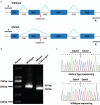A novel phenotype with splicing mutation identified in a Chinese family with desminopathy
- PMID: 30614851
- PMCID: PMC6365268
- DOI: 10.1097/CM9.0000000000000001
A novel phenotype with splicing mutation identified in a Chinese family with desminopathy
Abstract
Background: Desminopathy, a hereditary myofibrillar myopathy, mainly results from the desmin gene (DES) mutations. Desminopathy involves various phenotypes, mainly including different cardiomyopathies, skeletal myopathy, and arrhythmia. Combined with genotype, it helps us precisely diagnose and treat for desminopathy.
Methods: Sanger sequencing was used to characterize DES variation, and then a minigene assay was used to verify the effect of splice-site mutation on pre-mRNA splicing. Phenotypes were analyzed based on clinical characteristics associated with desminopathy.
Results: A splicing mutation (c.735+1G>T) in DES was detected in the proband. A minigene assay revealed skipping of the whole exon 3 and transcription of abnormal pre-mRNA lacking 32 codons. Another affected family member who carried the identical mutation, was identified with a novel phenotype of desminopathy, non-compaction of ventricular myocardium. There were 2 different phenotypes varied in cardiomyopathy and skeletal myopathy among the 2 patients, but no significant correlation between genotype and phenotype was identified.
Conclusions: We reported a novel phenotype with a splicing mutation in DES, enlarging the spectrum of phenotype in desminopathy. Molecular studies of desminopathy should promote our understanding of its pathogenesis and provide a precise molecular diagnosis of this disorder, facilitating clinical prevention and treatment at an early stage.
Figures




References
-
- Dalakas MC, Park KY, Semino-Mora C, Lee HS, Sivakumar K, Goldfarb LG. Desmin myopathy, a skeletal myopathy with cardiomyopathy caused by mutations in the desmin gene. N Engl J Med 2000;342:770–780. doi: 10.1056/nejm200003163421104. - PubMed
-
- Gudkova A, Kostareva A, Sjoberg G, Smolina N, Turalchuk M, Kuznetsova I, et al. Diagnostic challenge in desmin cardiomyopathy with transformation of clinical phenotypes. Pediatr Cardiol 2013;2:467–470. doi: 10.1007/s00246-012-0312-x. - PubMed
-
- Hong D, Wang Z, Zhang W, Xi J, Lu J, Luan X, et al. A series of Chinese patients with desminopathy associated with six novel and one reported mutations in the desmin gene. Neuropathol Appl Neurobiol 2011;37:257–270. doi: 10.1111/j.1365-2990.2010.01112.x. - PubMed
-
- van Spaendonck-Zwarts KY, van Hessem L, Jongbloed JD, de Walle HE, Capetanaki Y, van der Kooi AJ, et al. Desmin-related myopathy. Clin Genet 2011;80:354–366. doi: 10.1111/j.1399-0004.2010.01512.x. - PubMed
MeSH terms
Substances
Supplementary concepts
LinkOut - more resources
Full Text Sources
Medical

